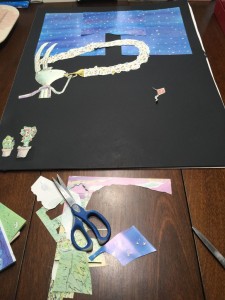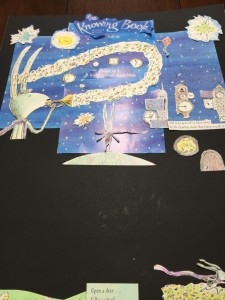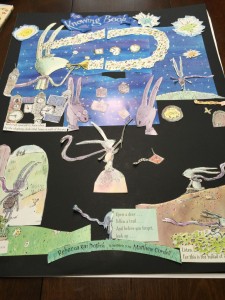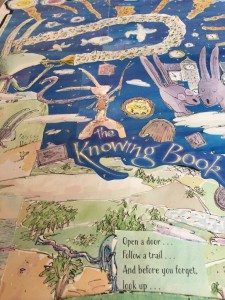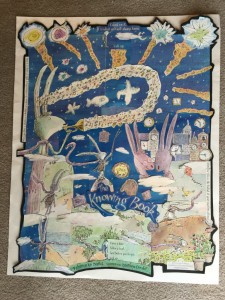Receiving an F&G copy of Rebecca Kai Dotlich’s forthcoming title, The Knowing Book, was a thrill and a blessing this month. To have an early look at what I predict will be a very popular, heavily-recommended book this spring puts me into a small group of readers who get to–as the hare does in the picture above–trumpet the whimsy and beauty of this new work.
A young hare leaves the hutch with an invitation to wonder. . .and ultimately to know. Dotlich’s gentle, guiding verse is like a voice to the hair that will resonate with readers. We talk about “One Book/Four Hands” titles here at These 4 Corners, and The Knowing Book is one that we will be thinking of on a short list of books that fit this very description. Messages coming out of The Knowing Book will instantaneously cast the one reading as the kind of sage who knows about roads, about journeys, about a path that invites and a sky that guides. That Cordell has chosen a hare as main character puts The Knowing Book on an immediate “ladder” (Lesesne) with classics like Guess How Much I Love You. It’s themes of “knowing” and “mindfulness” will be welcome alongside classics like Margaret Wise Brown’s The Important Book. For contemporary pairings, one might look to couple Dotlich’s book with Amy Krause Rosenthal’s I Wish You More from earlier this year.
Quiet suggestions that choices will come to the one who journeys forth are dove-tailed with subtle suggestions for the way in which one might navigate those choices made along the way. For this, one might put Dotlich’s The Knowing Book alongside of Robert Frost poetry for a unique pairing. It is the opinion of this reviewer that The Knowing Book could find itself in the category of What Book Should I Give the Graduate?
And isn’t it funny. . .as a quick aside. . .that when we think of books we may place into the hands of graduates (suggested/supported by sales figures) that we–as a culture–go back to the picture book vs. a book that would be on the readers’ level for this time in their academic journey?
The verse of Dotlich paired with Matthew Cordell’s illustrations make place this book into a category of iconic pairings like McCartney and Wonder. Like Crosby and Bowie. Like Houston and Carey. Like Dre and TuPac. You get the picture. The unique personalities–to include the quirky and unexpected–come together to create something that you would not want to have imagine either party having to do separately now. And this is what remixing picture books can be all about. . .getting the picture. And retelling the story at the same time.
And remixing The Knowing Book has taught me a lot about pulling the pictures. . .and the thoughts. . .out to put them back together again.
And what a challenge this one has been. I want to take one second in case he is reading to thank Matthew Cordell for every single tiny butterfly that appears within the remix. I want to thank him for every scarf that stretches out into the wind. I want to thank him for every tiny hare arm that points to a direction. I want to thank him for a stick that points to a destiny.
Because. . .in remixing. . .as in reading. . .we are going to have challenges wherein the lines are a little more subtle. The ideas a little more fragile. The reporting back a little more complicated. And for all of this, we are going to need something that our student readers don’t always get: incubation time.
This is the earliest putting together of what might be the final remix for The Knowing Book. By the way, F&Gs really work nicely here. If you can get them, do. The glossy pages actually act as stickers once you get a little tacky glue on the back of them. And then, they slide very nicely until the glue begins to settle. But at this stage, these are all pieces. I know that the hare blowing the horn is going to be central to the final composite. But, do I want him in the middle, or do I want to use Cordell’s looping notes and symbols to suggest something by way of moving from left to right? Another interesting point is that I have started from the top down in this remix vs. from the bottom up (the way in which I usually arrange early remixes).
See? I don’t have to start at the beginning. That’s more along the lines of plot summary. This happens. And then this happens. Oh, and then this. When I begin this remix, I am thinking about the importance of a signpost (Beers and Probst) that comes up “Again and Again”:
“Look up.”
And to get the people who will look at this remix later on to “look up” as invited by the text, I have to show them the “up” of this book. We all have to know “up” by the end, don’t we?
More elements of the book are now working their way into the remix. To show the journey forth, we have to show the stepping out. Cordell illustrates this beautifully as the hair opens the door to the hutch seemingly at the invitation of a small yellow bird. This gives me a little bit of time to think about the importance of knowing one’s surroundings as much as appreciating the grand sky and universe above. I begin looking at the other elements of the book, thinking that this remix must be grounded in the things of the earth as much as the sky.
And I’m thinking, “Next month, our Room 407 Readers will begin The Crucible. With students in the room, I am working on what will be my seventieth time reading this place from Act I to Act IV with students. And it’s something that came out of remixing a picture book that will help to guide some of our conversations. There is an old adage in the ministry that holds that is one’s vertical alignment is plumb, the horizontal elements will take care of themselves (and this is certainly something we can pull right into a concept of four corners). By taking the time to consider Dotlich’s verse with Cordell’s depictions, I am seeing the protagonist, John Proctor, in a whole new light: in light of what is happening around him in conflict with what is happening within him in contrast with what is suggested is happening above him. Of course, these are reflections for another time, but I want to demonstrate that the ability to visit with and consult with a picture book even with scissors in hand help me to “look up” from the immediate work that I am doing to see the extended work that I wish to do.
Now. . .here is where the remixing of The Knowing Book gets interesting.
I began this project on Wednesday with the holiday approaching. I work at my kitchen table which we really needed for the holiday, so I gathered up this project and moved it downstairs. This means that all of the elements are now moving and shifting. Nothing is glued down at this point. I grabbed this quick picture so that I would have a reference for later on.
Do you see and hear it?
That’s incubation. I knew that I wouldn’t be coming back to this remix for a couple of days. So I grabbed what I could of the work that I was going at the time so that I could get right back into it when I returned to the work some four days later. What are we doing in our classrooms that could foster this kind of “capture” or “freeze” imagery so that we can return to the work when it is time?
Here is a next-to-last image of the final remix of The Knowing Book. Still. . .little is glued down here. I am still asking myself the essential question: What do I need to show to demonstrate that I know this book? I’m still unsettled in my bringing this book back by way of remix because when I do these, I am trying to bring back the book in the images I find and the arrangement of those images. There is an old joke about a man who is invited to run around the block. He quips, “Why bother? I am already here.” And this is the challenge of remixing. The story has already been laid out in thirty-two page formatting. The work has already been vetted-out. Completed.
But isn’t this also true when we ask our students to go back into a piece of writing that has already been completed to ask them to pluck apart the pieces to bring them back in a manner that will look much like the product brought back by each of their peers in the room?
How do I show that I know a book?
Living. Loving. Laughing. Learning.
Four corners. It’s not just a concept. It’s a frame. It’s a frame for this remix and it’s a frame for the approach.
Do I know how to live? Do I know that doors open and that they close? And this is they work at a fundamental level?
Can I bring back mother and father hare and every picture frame Cordell has placed upon the dirt walls of a hutch to symbolize that we do not walk out there alone?
Can I see the humor and playfulness in clouds that look like dinosaurs, birds, and fish? That they are calling me to give them names as I “look up” as invited by the text?
And have I learned that the synthesis now. . .of words and images. . .of time and patience. . .of thinking and arranging. And finally coming to a place where I can settle all of this down within a frame of four corners to bring back this:
One of the more challenging remixes that I have done. And this includes Robert McCloskey’s Make Way for Ducklings (and when I meet McCloskey in heaven one day, I will say something to him about thin brown lines). In order to bring back The Knowing Book in a singular panel presentation. . .or remix. . .I had to bring back both verse and image.
And then. . .I had to discern which person within the collaboration offered which? Dotlich’s lines are presented in such a way that you might follow them if they were cast upon a billboard or tacked to a small wooden sign at the side of a trail. Cordell’s birds are calling us to take flight–even if by way of kite’s proxy–and reminding us of a home that calls us back when we are ready to return. The ability to highlight (isn’t this an interesting term in light of the book) Dotlich’s words is to say, “Don’t miss this” as much as tucking them into a scarf of Cordell’s running rabbit’s scarf is a means of saying, “Look over here too when you have a little more time.”
Words and images can come together in unique and surprising ways. Even when we think we have a sense of how they might be brought back.
A hobby can mean something to a larger public. I have no corner on scissors and glue. Or approach. Patenting a remix approach is like trying to patent a puzzle cube. I want you to try these. I want you to do these with your students.
Sharing our work by way of social media creates exciting new connections out there.
These are good things to “know.”
